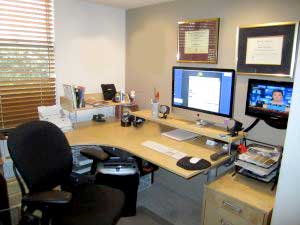Our world is changing, and both business and home owners must change along with it.  One significant change we’re seeing is the proliferation of home offices. People are working from home more than ever—some temporarily and some on a more permanent basis. In either case, they have to adapt their living situation to accommodate building a home office. However, in many cases, you can’t just make changes on your own—it’s important to do it right.
One significant change we’re seeing is the proliferation of home offices. People are working from home more than ever—some temporarily and some on a more permanent basis. In either case, they have to adapt their living situation to accommodate building a home office. However, in many cases, you can’t just make changes on your own—it’s important to do it right.
Space Requirements
Think about where in your home to locate your home office. It is best to dedicate a private space such as an unused bedroom, attic or basement areas, or an outbuilding. This way you can shut the door to create an undisturbed working environment as well as shut the door at the end of the day.
Other aspects of space requirements involve storage. You will likely require filing cabinets, furniture and/or shelving to hold business equipment and office-related items. Set it up to function as if you were going into the company. The more office-like your work space is, the more efficient you will be.
Electrical Requirements
Many homes, especially older homes, are not outfitted with either enough or the right type of electrical outlets to accommodate modern office technology needs. Think about placement of your electrical equipment, desk and lighting when devising your electrical plan, along with your electrical requirements.
Consult with an electrician who can review your existing electrical circuitry, including the electrical panel and breakers. With the extra energy load, you may need to upgrade your panel and/or your wiring. In addition, it may be wise to consider having a qualified electrician install a separate circuit or structured wiring specifically designed to handle your home office.
There are a few “dont’s” as well. NEVER use extension cords to run office equipment. While fine for a very short period, they are not suitable for long-term use. They not only draw a lot of current, they are a fire hazard. Never run power cords, electrical cords or extension cords underneath carpet.
DO NOT overload wall outlets. Plugging too many items into one outlet is both a bad idea and a fire hazard. Have your electrician upgrade your existing outlets to those with safety features while adding additional outlets to your home office.
Energy Efficiency
Choose energy-efficient equipment and lighting when building out your home office. This will reduce the energy load on your home and save you money. Look for EnergyStar labels. Battery-run items can also reduce your electrical load.
Requirements for Building a Home Office
Any construction or electrical work for building a home office IS subject to local and national building codes, and sometimes zoning, requirements. You or your contractor will need to obtain a building permit from your local jurisdiction, and your project will need to be inspected by the local official before you will get a certificate of occupancy for your new home office. It is important to do it right the first time in order to avoid problems down the road, especially when it’s time to sell.
Först Consulting Group is your Homeowner Advocate
If you’re not sure what you need for building a home office, need assistance in vetting a qualified contractor, or have a complaint against a contractor, that’s where we come in. Först Consulting Group offers a range of homeowner services that can either help you avoid problems in the first place, or resolve issues.
Let us review your construction contract to make sure it’s fair to YOU and not just the contractor, or hire us to manage your construction project or go behind the scenes to make sure your contractor is doing the best work possible. If you suspect a problem, bring us in to inspect the issue and give a detailed report that you can use to win your suit against the contractor. Please review our website for these and other homeowner services.


